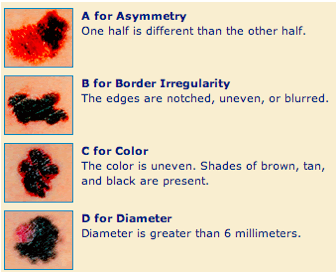Dysplastic Nevi Removal in New York
Dysplastic (abnormally-growing) nevi (moles) are also called atypical nevi.
As their name implies, they are abnormal-looking moles that may appear a lot like melanoma. Normal moles are common, small brown dots. Dysplastic nevi tend to have uneven color with dark brown centers and lighter, uneven edges. They can occur in almost everyone. They are generally normal-looking: symmetrically round and regularly shaped. Dysplastic nevi, on the other hand, are usually larger than common moles, have irregular borders, and can have different colors in the same mole. They are most common on the trunk of a male, but also as common on the calves on a female.
In order to tell if melanoma is present through dysplastic nevus is by looking for signs and symptoms of “ABCDE”
- Asymmetrical skin lesion
- Border of the lesion is irregular
- Color: melanoma usually has multiple colors
- Diameter: a mole greater than 6 mm is more likely to be melanoma
- Evolution: the evolution or change of the mole may be an early sign that the mole is becoming malignant.
Melanoma can even develop within a dysplastic nevus. There is a higher risk of melanoma in those with dysplastic nevi than in the general population. People with this skin condition may have more than 100 moles. The greater the number of dysplastic nevi present, the greater the risk that a person has of developing melanoma. Because of these risks, those with dysplastic nevi need regular skin exams by a dermatologist. If you suspect you may have dysplastic nevi, it is very important that you make an appointment to see an experienced dermatologist such as Dr. Rokhsar. The dermatologist will likely perform a biopsy in order to determine if your moles are in fact dysplastic.
Dysplastic Nevi Removal FAQ
What is Dysplastic Nevi Syndrome?
Dysplastic nevi syndrome, also known as familial melanoma syndrome is the overdevelopment of abnormal/atypical moles. Dysplastic Nevi Syndrome is an inherited condition characterized by multiple atypical moles and an increased risk of melanoma. This disorder is also called FAMMM (Familial Atypical Multiple Mole and Melanoma syndrome).
Those with DNS tend to acquire melanoma at an earlier age than those without abnormal moles. For individuals with DNS, having a family member who has had melanoma increases the risk of developing melanoma. About 2 to 8 percent of the Caucasian population has Dysplastic Nevi and those with two or more close blood relatives that have the disease, have an increased risk of developing melanoma, a serious type of skin cancer. However, those individuals who have dysplastic nevi syndrome and have no family history of melanoma, have a 27 times higher risk of developing melanoma compared to the general population. Individuals with this disorder have many large moles with differing shades of color. This predominantly develops in patients with a clear complexion, blue eyes, and the presence of numerous nevi. Lesions are located mainly on the upper trunk, back, limbs, abdomen, and arms. The number of moles can range from 50 to over 100. At least one of the moles is over 8 mm in diameter. At least one mole will have abnormal features such as: asymmetry, variable color within the mole, irregular borders, size over 6mm, or rapid change in appearance. If you suspect you may have atypical moles or atypical mole syndrome, make an appointment with your dermatologist at your earliest convenience. The doctor may examine the mole(s) with a dermatoscope, or may perform a biopsy.
What to do with Dysplastic Nevi?
Individuals with dysplastic nevi should take certain steps to monitor and protect their skin. Dysplastic nevi are moles that are larger and irregular in shape than average moles and have an increased risk of developing into melanoma, the most serious form of skin cancer. It is crucial to detect and treat dysplastic nevi early to avoid potentially fatal outcomes.
Because people with multiple dysplastic nevi are at a higher overall risk to develop melanoma anywhere on their body,it is essential to perform self-exams regularly and visit a board certified dermatologist for a full-body skin check at least once a year. During a skin exam, your dermatologist can identify any moles that appear atypical or suspicious and may recommend a biopsy to determine if it is cancerous or not. Moderate or severely dysplastic nevi should be surgically excised by your dermatologist.
Protecting your skin from UV radiation is also essential in preventing the development of dysplastic nevi. This includes wearing protective clothing, such as hats and long-sleeved shirts, and applying a broad-spectrum sunscreen with an SPF of at least 30 daily. Avoiding tanning beds and seeking shade during peak sun hours can also help reduce your risk of developing skin cancer.
In some cases, dysplastic nevi may need to be removed, particularly if they appear severely atypical or have changed in size, shape, or color. The best treatment option will depend on the severity of the mole and should be discussed with a board certified dermatologist. Mildly dysplastic nevi may not require further treatment, while severely dysplastic nevi should be surgically removed.
It is essential to know your skin and be vigilant in monitoring any changes in your moles or the appearance of new moles. Early detection and treatment of dysplastic nevi can significantly improve your prognosis and potentially save your life.
New York Office Locations
Upper East Side Manhattan Office
121 East 60th Street, Suite 8AB New York, NY 10022
(212) 285-1110
Long Island Office
901 Stewart Ave, Suite 240, Garden City, NY 11530
(516) 512-7616



 Dr. Rokhsar was chosen by
Dr. Rokhsar was chosen by 






